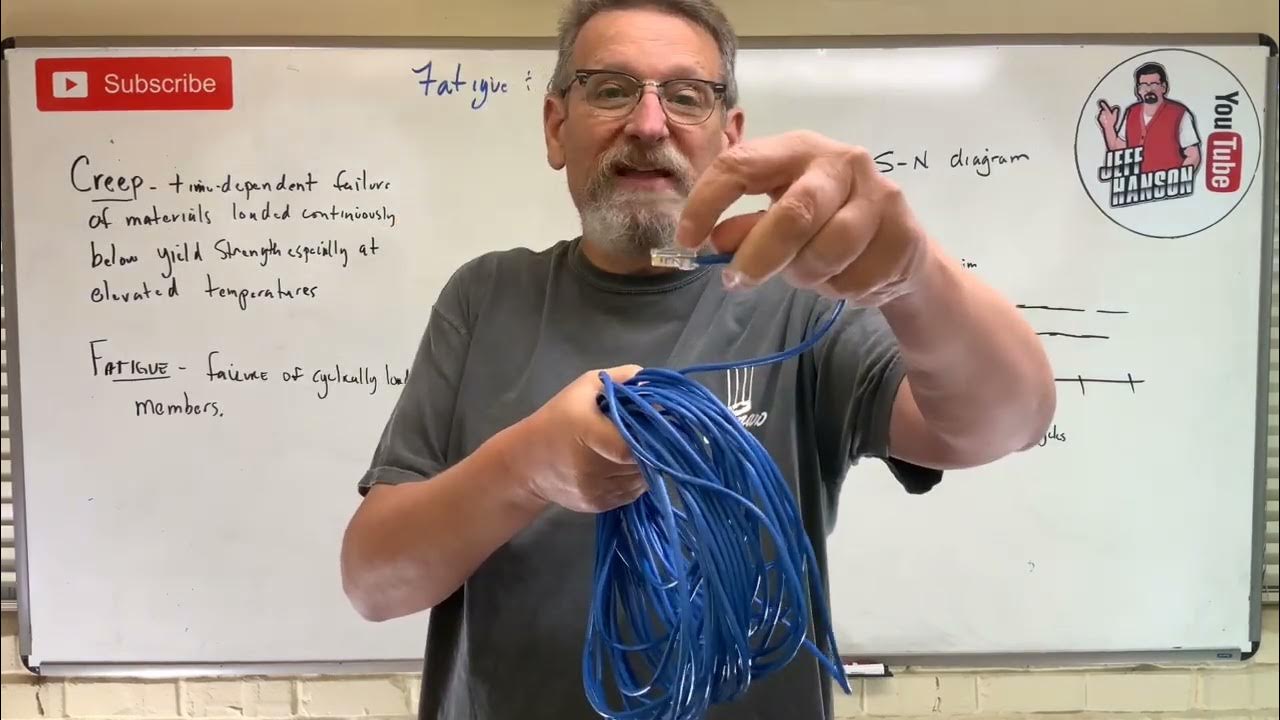CREEP TEST EXPLAINED
Summary
TLDRThis video explains the concept of creep, which is the gradual deformation of a material under constant stress and high temperature. It details the process of creep testing, using a constant load creep testing machine to assess material behavior over time. The video covers key components of the test, including grips, loading platforms, and heating chambers, and discusses the three stages of creep: primary, secondary, and tertiary. It also highlights how the results from creep testing can help engineers select the most suitable materials for various applications, based on their performance under stress and heat.
Takeaways
- 😀 Creep is the tendency of a material to change form over time when exposed to high temperature and stress.
- 😀 Creep increases with temperature and is more common when a material is subjected to high temperatures for extended periods or near its melting point.
- 😀 A creep test measures the progressive rate of deformation of a material at high temperature, typically conducted using a tensile specimen and constant stress.
- 😀 Engineers and researchers use creep machines to understand material stability, behaviors under stress, and the process of metallurgy.
- 😀 Creep testing provides data to assess the mechanical properties of metals and the performance of alloys under specific conditions.
- 😀 The constant load creep testing machine is the most common type, featuring a loading platform, fixture devices, and a heating chamber.
- 😀 Proper alignment of the material in the creep machine is essential for accurate results, as misalignment can cause errors in measurements.
- 😀 A dial gauge is used to measure strain during creep testing, capturing the object's movements as the load is applied.
- 😀 Creep testing involves three stages: primary (rapid rate that slows), secondary (uniform rate), and tertiary (accelerated rate leading to rupture).
- 😀 The creep curve generated during testing is a time vs. strain graph, which helps to determine the best materials for specific applications.
- 😀 Creep behavior is influenced by changes in loading and temperature, and the mechanisms can vary significantly between metals, plastics, rubber, and concrete.
Q & A
What is creep in materials science?
-Creep is the tendency of a material to change its form over time when subjected to high temperature and stress. It is a slow, time-dependent deformation that increases with temperature and is more pronounced when materials are exposed to high temperatures for extended periods or at their melting point.
How does creep increase with temperature?
-Creep becomes more pronounced as temperature increases because high temperatures accelerate the movement of atoms or molecules within a material. This leads to faster deformation under stress, especially when the material is near or at its melting point.
What is the purpose of a creep test?
-A creep test measures the progressive rate of deformation of a material when exposed to a constant stress and temperature over time. It is used to assess how materials will behave under prolonged stress, especially at high temperatures.
What kind of specimen is used in a creep test?
-A tensile specimen, which is typically a sample of the material being tested, is used in a creep test. This specimen is subjected to a constant stress at a constant temperature.
What is the function of a creep machine?
-A creep machine is used by engineers and researchers to test materials under constant stress and temperature. It helps determine the material's stability, behavior, and mechanical properties, particularly under high temperature and load conditions.
What components are typically found in a constant load creep testing machine?
-A constant load creep testing machine typically consists of a loading platform, foundation fixture devices, furnace, grips, pull rods, a dial gauge to measure strain, and a load beam to transfer movement from the grips to the gauge.
Why is the alignment of the specimen important in a creep testing machine?
-Alignment is critical because improper alignment can result in inaccurate measurements during the creep test. If the specimen is not aligned correctly, the applied load and strain may not be distributed evenly, leading to incorrect readings of the material’s deformation.
What is a creep graph, and what does it show?
-A creep graph plots time against strain, showing how a material deforms over time under a constant load. The graph helps visualize the creep rate and provides insights into the material’s behavior under stress at high temperatures.
What are the three stages of creep?
-The three stages of creep are: 1) Primary creep, which starts at a rapid rate and then slows down; 2) Secondary creep, which has a relatively uniform rate; and 3) Tertiary creep, which accelerates and ends when the material breaks or ruptures, often due to necking or grain boundary voids formation.
How is creep affected by different materials like metals, plastics, rubber, and concrete?
-Creep behavior varies between materials. While metals typically experience creep at high temperatures, plastics and rubber also show significant creep under stress, especially when exposed to heat. Concrete, being more rigid, undergoes creep at much slower rates, but can still deform over long periods under sustained stress.
Outlines

This section is available to paid users only. Please upgrade to access this part.
Upgrade NowMindmap

This section is available to paid users only. Please upgrade to access this part.
Upgrade NowKeywords

This section is available to paid users only. Please upgrade to access this part.
Upgrade NowHighlights

This section is available to paid users only. Please upgrade to access this part.
Upgrade NowTranscripts

This section is available to paid users only. Please upgrade to access this part.
Upgrade Now5.0 / 5 (0 votes)





